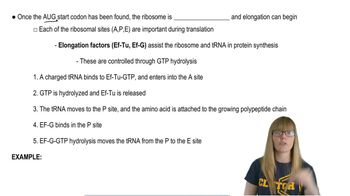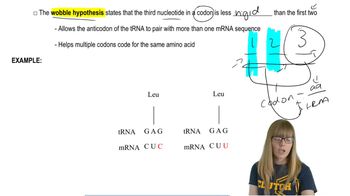- 1. Introduction to Genetics51m
- 2. Mendel's Laws of Inheritance3h 37m
- 3. Extensions to Mendelian Inheritance2h 41m
- 4. Genetic Mapping and Linkage2h 28m
- 5. Genetics of Bacteria and Viruses1h 21m
- 6. Chromosomal Variation1h 48m
- 7. DNA and Chromosome Structure56m
- 8. DNA Replication1h 10m
- 9. Mitosis and Meiosis1h 34m
- 10. Transcription1h 0m
- 11. Translation58m
- 12. Gene Regulation in Prokaryotes1h 19m
- 13. Gene Regulation in Eukaryotes44m
- 14. Genetic Control of Development44m
- 15. Genomes and Genomics1h 50m
- 16. Transposable Elements47m
- 17. Mutation, Repair, and Recombination1h 6m
- 18. Molecular Genetic Tools19m
- 19. Cancer Genetics29m
- 20. Quantitative Genetics1h 26m
- 21. Population Genetics50m
- 22. Evolutionary Genetics29m
11. Translation
Translation
Problem 37
Textbook Question
In terms of the polycistronic composition of mRNAs and the presence or absence of Shine–Dalgarno sequences, compare and contrast bacterial, archaeal, and eukaryotic mRNAs.
 Verified step by step guidance
Verified step by step guidance1
span>Step 1: Understand the concept of polycistronic mRNA. In bacteria and archaea, mRNAs can be polycistronic, meaning they can encode multiple proteins within a single mRNA molecule. In contrast, eukaryotic mRNAs are typically monocistronic, encoding only one protein per mRNA.</span
span>Step 2: Explore the role of the Shine–Dalgarno sequence. This sequence is a ribosomal binding site in bacterial and archaeal mRNA, located upstream of the start codon. It helps the ribosome recognize the start site for translation.</span
span>Step 3: Compare bacterial and archaeal mRNAs. Both can be polycistronic and contain Shine–Dalgarno sequences, but there may be differences in the specific sequences and mechanisms of translation initiation between these two domains.</span
span>Step 4: Contrast with eukaryotic mRNAs. Eukaryotic mRNAs are generally monocistronic and do not have Shine–Dalgarno sequences. Instead, they use a 5' cap structure and a Kozak sequence to facilitate ribosome binding and translation initiation.</span
span>Step 5: Summarize the differences. Bacterial and archaeal mRNAs can be polycistronic and use Shine–Dalgarno sequences, while eukaryotic mRNAs are typically monocistronic and use different mechanisms for translation initiation.</span
Recommended similar problem, with video answer:
 Verified Solution
Verified SolutionThis video solution was recommended by our tutors as helpful for the problem above
Video duration:
2mPlay a video:
Was this helpful?
Key Concepts
Here are the essential concepts you must grasp in order to answer the question correctly.
Polycistronic mRNA
Polycistronic mRNA is a type of messenger RNA that encodes multiple proteins within a single transcript. This is common in prokaryotes, such as bacteria and archaea, allowing for the coordinated expression of genes that are functionally related. In contrast, eukaryotic mRNAs are typically monocistronic, meaning they encode only one protein per transcript, which allows for more complex regulation of gene expression.
Recommended video:
Guided course

mRNA Processing
Shine-Dalgarno Sequence
The Shine-Dalgarno sequence is a ribosomal binding site in bacterial mRNA that is crucial for the initiation of translation. It is a short, conserved sequence located upstream of the start codon, facilitating the alignment of the ribosome with the mRNA. In archaea, similar sequences exist, but eukaryotic mRNAs do not have Shine-Dalgarno sequences; instead, they utilize a 5' cap structure for ribosome binding.
Recommended video:
Guided course

Sequencing Difficulties
Transcription and Translation Differences
Transcription and translation processes differ significantly between prokaryotes and eukaryotes. In prokaryotes, transcription and translation occur simultaneously in the cytoplasm, while in eukaryotes, transcription occurs in the nucleus, and mRNA must be processed (including splicing and capping) before it is translated in the cytoplasm. This separation allows for more complex regulation in eukaryotic cells.
Recommended video:
Guided course

Translation initiation

 7:58m
7:58mWatch next
Master Translation initiation with a bite sized video explanation from Kylia Goodner
Start learning



